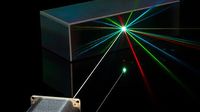Tunable Diode Lasers for Holography
Light-field recording with phase information
- Recording of patterns and pseudo-3D images
- Based on interference between object beam and reference beam
- Using the advantages and flexibility of single-frequency diode lasers
A hologram is a photographic recording of a light field that includes the phase information of the recorded field. This technique is commonly used to create a full three-dimensional image of the recorded object.
In the simplest of cases the object is replaced by a mirror. In this case, the recorded image is a regular pattern of dark and bright fringes – such, a straightforward way of producing gratings in a multitude of substrates is devised. These gratings can be used as diffractive elements, like the gratings inside Littrow diode lasers as the DL pro, or the gratings inside DFB/DBR lasers. Even the fiber Bragg gratings used for fiber lasers are produced in a similar manner.
Using a slightly different recording setup, the holograms can be used to replace standard optical components, i.e. mirrors, beam splitters, filters or lenses. This is the case in the flourishing field of augmented reality and mixed reality devices, which put the user in an environment where a clear vision of the surrounding real world is augmented with additional information provided by the device in full color (RGB).
The well-known general setup uses any 3D object and if the hologram is illuminated by a similar laser wavelength, a pseudo-3D image occurs which even includes depth information. Because of the wave nature of light, only parts of the hologram or partial illumination are sufficient to produce the image.
Today's hologram creation
Today, different laser wavelengths are used to create holograms. Originally, Helium-Neon lasers with a wavelength of 633 nm or various wavelengths from Argon/Krypton ion lasers were used as light source - both with limited power. Nowadays coherent diode lasers at 407 nm, 457 nm, 514 nm or 647 nm and even in the UV/RGB wavelength regions with power levels of several 100 mW have become the optimal choice for holography – especially in industrial applications. Whereas the original sources were bulky and operated at a fixed wavelength, diode lasers are tunable, so they perfectly match the user requirements.
- Related Products
-
Related Literature
- Article: Ulrich Eismann Direct and frequency-converted diode lasers provide all wavelengths for holography, Laser Focus World (2018), German version, Chinese version, Japanese version
- Article: Short, shorter, shortest: Diode lasers in the deep ultraviolet, Laser Focus World, June 2016
- Application Note: Resource-efficient generation of large-area micro and nanostructures, Photonics Views, February / March 2023
-
Related Applications

